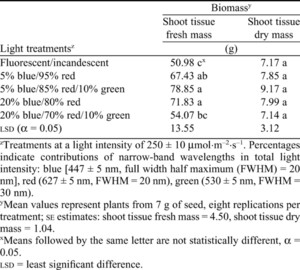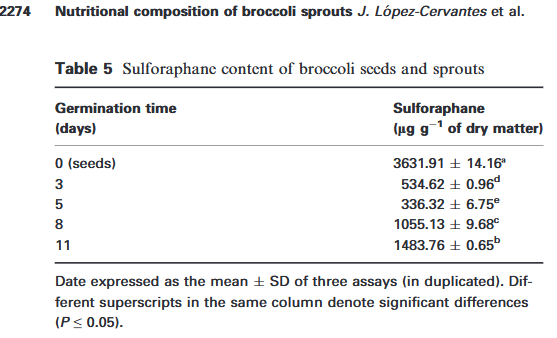cl-user
#1
For those interested, Johnny’s Seeds have High-glucoraphanin broccoli organic sprouting seeds
Unique variety selected for consistent and high levels of glucoraphanin, a precursor to the widely studied, powerful antioxidant sulforaphane. Developed in a traditional breeding program over 20 years. Plant Variety Protected. One tablespoon yields approx. 1–1 1/2 cups sprouts. All of Johnny’s high-germination sprouting seeds have tested negative for the presence of E. coli 0157 and Salmonella. USDA Certified Organic.
For those who prefer pills, CSHealth is providing pills with extracts from those seeds
Interestingly they are a subsidiary of the agricultural production company, Caudill Seed, that came up with those high-glucoraphanin broccoli variety.
4 Likes
One of our little grands (4y/o) is Autistic. I had read about sulphoraphane helping with that. He gets 1/2 a cap in a morning drink.
The difference for him is night and day. The change was almost immediate. He is more calm, more verbal and engaged. Before he would not look you in the eye. Now the first thing he does when we visit is run to you while looking at you can telling you how happy he is to see you. He talks a lot 
When he misses the S, you visibly see the difference in how he moves and acts.
Interestingly they had upped his dose a couple months ago and he became emotionally sensitive. Scenes in his fav movies would cause him to be overly sad or amped up. They went back to the normal dose and his stability returned.
We consider this a miracle supplement for him.
n a placebo-controlled, randomized, double-blind clinical trial, daily oral administration for 18 wk of the phytochemical sulforaphane (derived from broccoli sprouts) to 29 young men with ASD substantially (and reversibly) improved behavior compared with 15 placebo recipients.
https://www.pnas.org/doi/10.1073/pnas.1416940111
6 Likes
Very interesting. What is the effective mg dose? And, if you could share the brand used.
EnrQay
#5
Any data on how much more glucoraphanin in these seeds?
@ConquerAging did an interesting video on sulforaphane (https://youtu.be/08EPeCvxbLY?t=387) that included a table of how much is in seeds and sprouts by growing time, based on the journal article Biochemical composition of broccoli seeds and sprouts at different stages of seedling development.
It indicates that a longer germination time of 11 days might maximize the sulforaphane content. Unfortunately, this was stated in terms of micrograms of sulforaphane per gram of dry matter. How does the dry matter of a seed compare to that of an 11 day old sprout, apart from the sprout containing more? Without this info, I can’t compare the sulforaphane content of a seed versus an 11 day old sprout.
Anyone? To measure this, I could dehydrate my sprouts and compare. I haven’t done this yet, as I would largely negate health benefits. I’ll report back if anyone is interested.
1 Like
JuanDaw
#6
The study below freeze dried the sprouts. Might be the same method used in the study you posted, when the referred to “dry matter”.
Sprouting broccoli tissue glucosinolate extraction.
Glucosinolates were extracted from freeze-dried tissues and analyzed according to Kopsell and Sams (2013)
cl-user
#7
I don’t know but this is from their FAQ :
Our products are made with our Plant Variety Protection (patented) seed that contain up to Three times the amount of sulforaphane glucosinolate that is normally found in commercially available seed. As a result, our seed and broccoli sprout products contain superior amount of sulforaphane glucosinolate. Incidentally, our seed is produced without bioengineering.
1 Like
EnrQay
#8
Warning: math ahead!
From this paper, after 20 days of growth, the fresh mass/dry mass ratio is roughly 8x-9x (say 8.5), varying by light condition:
 .
.
My most recent batch of 53g of seeds produced 690g fresh sprouts, which converts to about 81g of dry mass, a 53% increase over 11 days of growing. But compare this to the amount of sulforaphane in seeds versus dry mass of sprouts from the first paper:

The sprouts at day 11 have 41% of the sulforaphane per dry gram compared to seeds, but 53% more dry mass, yielding only 63% (=0.41*1.53) of the sulforaphane of the seeds I started with.
So why aren’t we all just grinding up seeds and adding a little mustard powder to aid in the conversion of glucoraphanin to sulforaphane? I might eat 100 grams of fresh sprouts with lunch, or instead, by this calculation, I could eat 7.4g (=100/8.5*0.63) of ground seeds and get the same sulforaphane.
2 Likes
JuanDaw
#9
That is what I used to do, and will resume doing, after being reassured about the erucic acid content of broccoli seeds. I posted about that in the second link by RapAdmin above.
1 Like
We use the Swanson brand of sulphoraphane and his dose is 1/2 cap = 200mcg
Edited to adjust the dose
1 Like
EnrQay
#11
FWIW, according the table above, 1g of seeds has 3631mcg of sulforaphane.
EnrQay
#12